[av_notification title=’BcgTeam’ icon_select=’yes’ icon=’ue812′ font=’entypo-fontello’ close_btn=” cookie_lifetime=’60’ color=’green’ custom_bg=’#444444′ custom_font=’#ffffff’ border=” size=’large’ custom_class=” av_uid=’av-2qkxqd’ admin_preview_bg=”]
PVsys به طور اختصاصی توسط تیم Bundlecg کرک شده و به روزرسانی می گردد و به صورت رایگان در قسمت VIP در اختیار اعضا می باشد.
[/av_notification]
نرم افزار PVSyst یک بستهٔ نرمافزاری کامل برای مطالعه، اندازهگیری، شبیهسازی و تجزیه و تحلیل سیستمهای PV است. این نرمافزار به معماران، مهندسان و محققان مرتبط است. این نرمافزار همچنین شامل کمکهایی گسترده مبتنی بر متن است که در آن جزئیات روشها و مدلهای استفاده شده را توضیح میدهد. این امر با راهنمای «خط سبز» و سطوج مختلف پروژه یک رویکرد ارگونومیک ارائه میدهد. در این نرمافزار میتوان سیستمهای متصل به شبکه و DC و پمپهای خورشیدی را شبیهسازی کرد. همچنین خواهید توانست با ورود اطلاعات راجع به بار مصرف شده مدت زمان مصرف سیستم خورشیدی مناسب خود را تولید کرده و آنرا بهینه سازی کنید. همچنین میتوان در این نرمافزار وجود سایه را هم بررسی کرد. با ورود اطلاعات جغرافیایی و ارتفاع از سطح دریا میتوان از اطلاعات واقعی میزان تابش خورشید استفاده کرد.
نرم افزار PVsyst به عنوان نرم افزار اصلی طراحی و مدلسازی نیروگاه های خورشیدی مورد استفاده پیمانکاران، سرمایه گذارن، دانشگاهیان و فعالان این حوزه قرار گرفته و با قابلیت هایی که دارد توانسته است بعنوان یکی از مهمترین نرم افزارهای شبیه سازی نیروگاه های خورشیدی در دنیا استفاده شود و به عقیده بسیاری از کارشناسان، این نرم افزار قوی ترین نرم افزار طراحی نیروگاه خورشیدی دنیاست.
این نرم افزار به طور مستمر در دانشگاه ژنو سوئیس ارتقا داده می شود و مرتبا در حال بهینه سازی می باشد. برنامه pvsyst طیف کاملی از امکانات را دارا می باشد که به عنوان نمونه ابزار سه بعدی برای سایه توسعه یافته، توانایی وارد کردن داده ها، مقایسه مقادیر شبیه سازی شده، جعبه ابزار برای تعیین هندسه خورشیدی، هواشناسی و رفتار عملیاتی سیستم های فتوولتائیک از این دسته اند. از نرم افزار PVsyst برای شبیه سازی و طراحی سیستم های خورشیدی در سطوح کیلوواتی و مگاواتی، به صورت متصل به شبکه و منفصل از شبکه همچنین طراحی پمپ های آب خورشیدی استفاده می گردد.
PVsyst نرم افزاری کامپیوتری جامع و کاربردی در زمینه کار با سیستم های خورشیدی می باشد که شامل مجموعه ابزارهای لازم برای مطالعه و تحقیق، سایزبندی، شبیه سازی و آنالیز داده های سیستم های PV است و با هدف کمک به معماران،مهندسین، پژوهشگران و حتی دانشجویان علاقمند به تحقیق و کار در این حوزه، طراحی شده است. این نرم افزار شامل یک منوی راهنما (Help)بسیار دقیق است که مدل ها و روش هایی که مورد استفاده قرار می گیرند را کاملاً توضیح می دهد تا هر شخصی قادر باشد در یک محیط کاملاً کاربرپسند و شهودی، پروژه ی خود را آغاز نموده و به اتمام برساند.
در PVsyst قادر به وارد کردن داده های هواشناسی از منابع مختلف، و همچنین اطلاعات شخصی (به صورت دستی) و سپس آنالیز و گزارش گیری از آن ها خواهید بود.
امکانات و ویژگی های نرم افزار PVSyst
- مشخص کردن قدرت مورد نظر یا منطقه در دسترس
- انتخاب ماژول PV از پایگاه داده داخلی
- انتخاب معکوس کننده از پایگاه داده داخلی
- پیشنهاد یک آرایه و پیکر بندی سیستم برای انجام یک شبیه سازی مقدماتی
- نشان دادن منحنی I/V از آرایه PV, همراه با محدوده MPPT, ولتاژ, توان و محدودیت های فعلی معکوس کننده
- نمایش توزیع سالانه قدرت آرایه
- ارائه ابزار های تخصصی برای ارزیابی خسارات سیم کشی (و ضرر و زیان های دیگر مانند کیفیت ماژول), عدم تطابق بین ماژول, رفتار حرارتی با توجه به نصب مکانیکی, در دسترس نبودن سیستم و…
- تولید کل انرژی MWh/y برای ارزیابی سودآوری سیستم PV
- انرژی خاص kWh/kWp شاخص تولید بر اساس پرتو افکنی در دسترس (محل و جهت گیری)
- نشان دادن انرژی اصلی و دستاورد ها/تلفات گرفتار در شبیه سازی
- ابزار قدرتمند برای تجزیه و تحلیل سریع رفتار سیستم و بهبود بالقوه در طراحی
- جستجوی مستقیم برای یک مکان با استفاده از نقشه های گوگل
- محاسبه مدار الکتریکی در ورودی هر اینورتر
- بهبود مدیریت پروژه: دسترسی پارامتر, کپی, قالب
- ابزار برای بهینه سازی پارامتر
A powerful software for your photovoltaic systems
System Design Board
The system design is based on a quick and simple procedure:
- Specify the desired power or available area
- Choose the PV module from the internal database
- Choose the inverter from the internal database
and PVsyst will propose an array/system configuration, that allows you to conduct a preliminary simulation.
The software embeds a color-coded warning / errors messaging system. If there’s a mismatch, issue, warning with your design, you will be warned within the proper frame.

System sizing: Visual tool
A specific tool gathers all constraints for the sizing of the system :
For the number of modules in a series: the upper diagram shows the I/V curve of the PV array, together with the MPPT range, voltage, power, and current limits of the inverter.
- For the inverter sizing: the second graph displays the annual distribution of the array power, with the array and inverter nominal power
- The optimal sizing of the inverter is based on the acceptable overload loss throughout the year. It usually leads to over-size the power ratio (array nominal power by respect to the inverter nom. AC power), by a factor of 1.25. After a good system sizing, you can define different losses like far and near shadings using a full 3D editor for the definition of the environmental and near shading conditions. Specialized tools are also provided for the evaluation of the wiring losses (and other losses like the module quality), the mismatch between modules, soiling, thermal behavior according to the mechanical mounting, system unavailability, etc.

3D Shading Scene
- User-friendly object manipulation and creation
- Easy import from external CAD tools (Sketchup, Helios3D, AutoCAD, etc)
- Quick design: sheds layout, zones of tables
- Orientation identification and scene validation tools
- Sun Point of View Simulation
- Multithreaded shading calculations
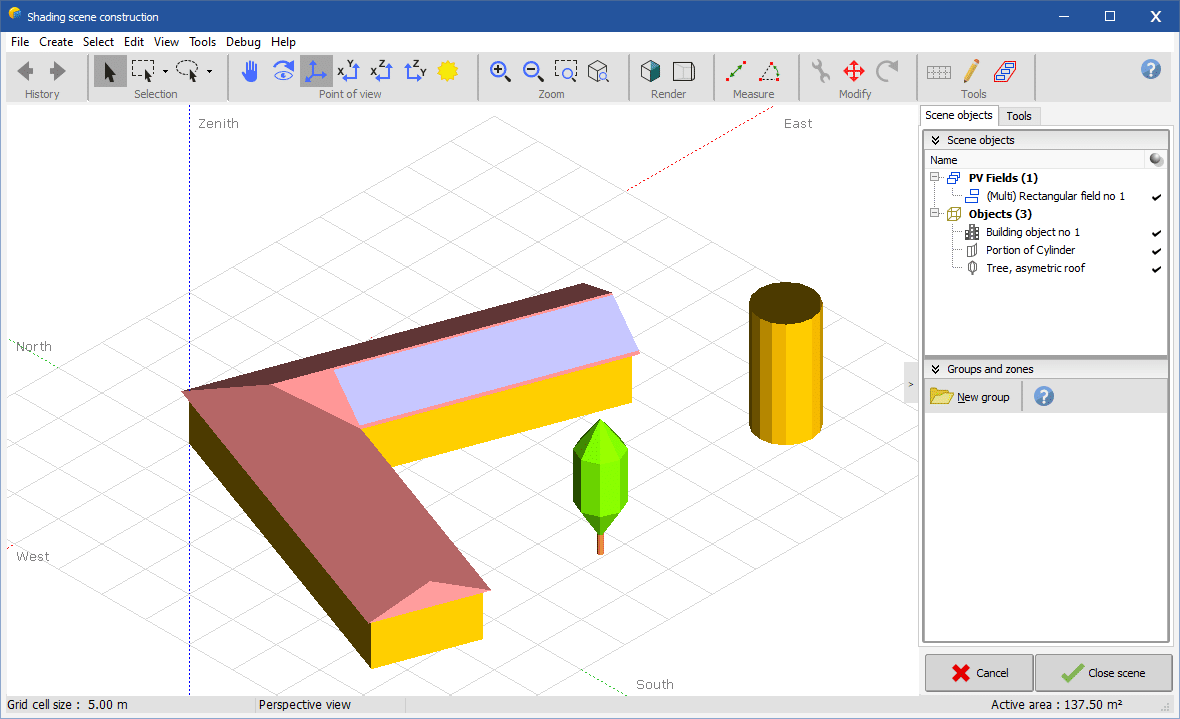
Simulation and results report
The simulation calculates the distribution of energies throughout the year.
Main results:
- The total energy production [MWh/y] is essential for the evaluation of the PV system’s profitability.
- The Performance Ratio (PR [%]) describes the quality of the system itself.
- The specific energy [kWh/kWp] is an indicator of production based on the available irradiation (location and orientation).
- Shows the main energies and gains/losses involved in the simulation,
- Powerful tool for a quick analysis of the system’s behavior, and potential improvements in the design.

Grid Storage
Storage in a grid system is a complex feature, as it may have different objectives, which lead to different strategies and different PV system configurations. Up to now, we have developed 3 strategies in PVsyst:
- the storage for enhancing the self-consumption of the PV system owner.
- a storage for ensuring peak shaving, when the possible power injected into the grid is limited.
- a storage for the continuity of the user’s electricity feeding, when the grid is weak and often unavailable.
In each case the energy fluxes are different and lead to different simulation results.
As an example we show the energies involved in a self-consumption PV system.
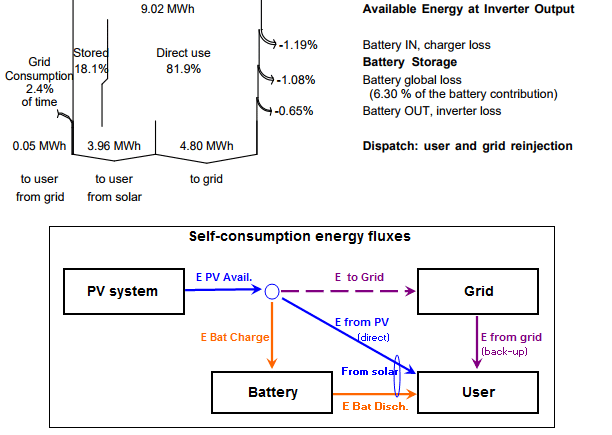
Meteonorm included – 7.2
- Direct search for a location using OpenLayers and GeoNames
- Full Meteonorm v7.2 interpolation program for any location on earth

PV modules and Model Management, Inverters
PV modules and model Management
- Sandia model implementation and comparison with PVsyst model
- Tools for optimization parameters (low-light, I/V curve)
- New parameters (tolerance, IAM profile, Vmax UL)
- Optimizers (SolarEdge and Maxim)
Inverters
- New parameters (Transfo, CEC efficiency)
- Multi-MPPT with asymmetric inputs (unbalanced) and advanced Power Sharing
- Improvement of choice by manufacturer

Ageing
Multi-year batch simulation:
- For different operating years, same meteo data
- For a set of yearly meteo data files
- Results and graphs on the report
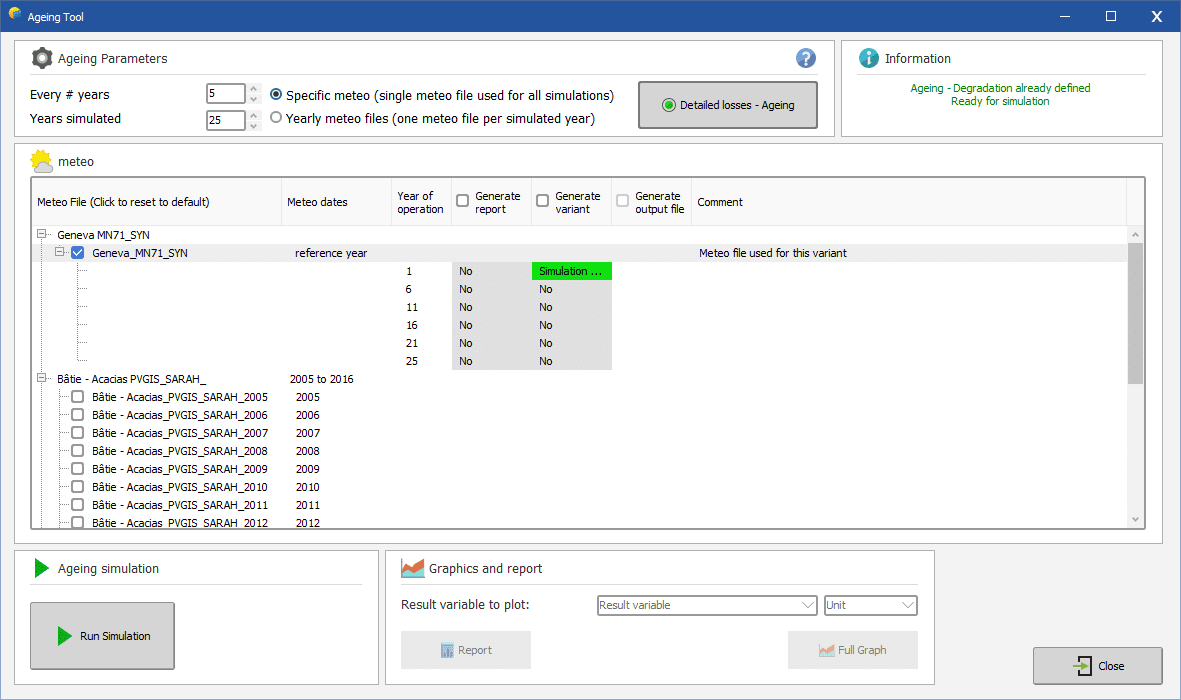
Bifacial calculations
Bifacial model for tracking 1-axis systems (unlimited trackers)
- Improved the import parameters from the “real” system defined in 3D
- Conceptual error in the model, which lead to an underestimation of the rear side irradiance by a factor of 1/GCR (i.e. a factor of 2 or more!)
- Add the contribution of the Diffuse seen from the rear side.
- Albedo in monthly values.Seasonal orientation: possibility of negative summer tilt for low Latitudes
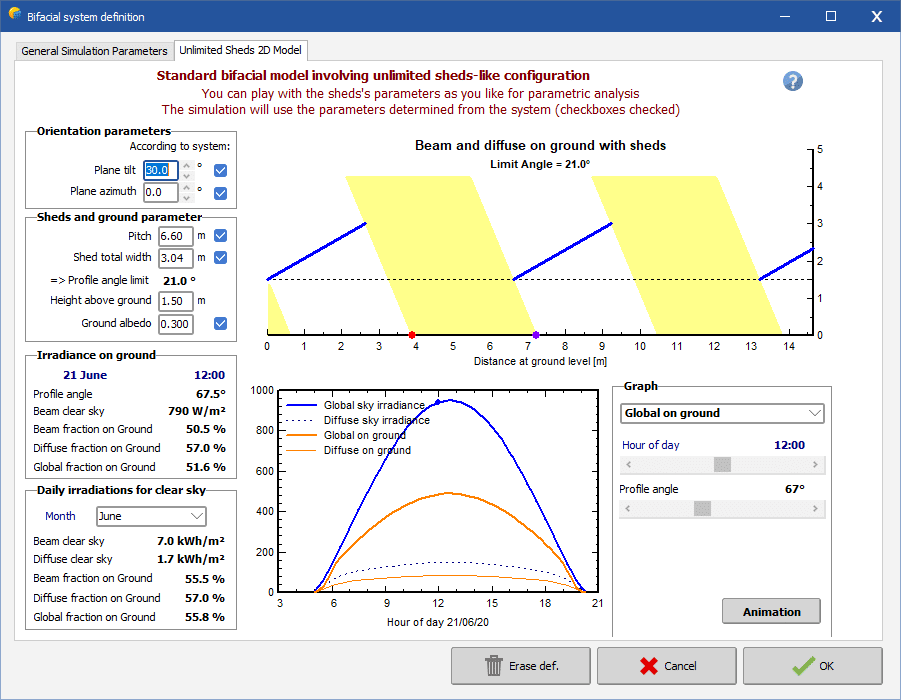
Batch calculations
Batch mode and sheds optimization tool
- Modification of the pitch as parameter
- Bi-facial: height above ground as parameter
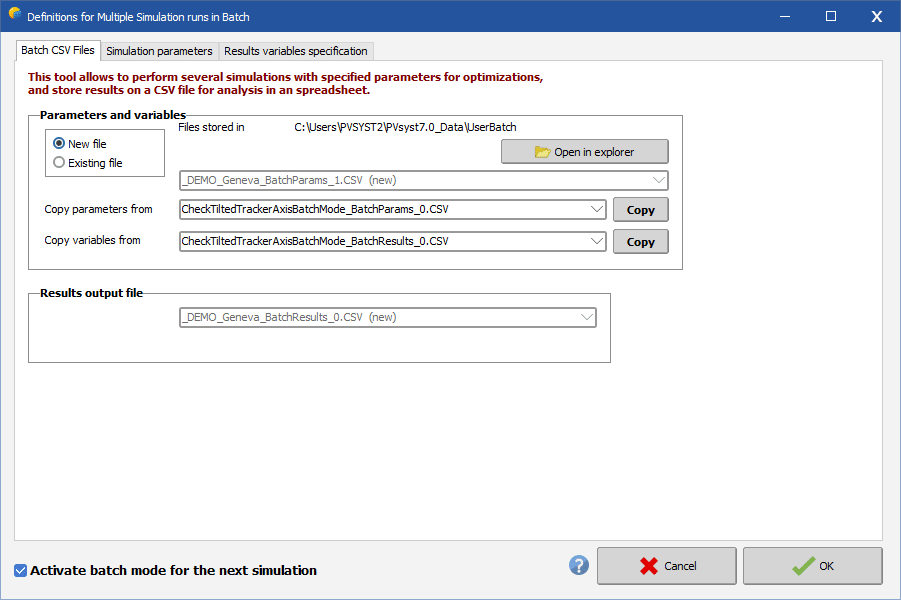
Economic evaluation
System cost evaluation:
- CAPEX (installation cost)
- OPEX (operating costs)
- Abiltiy to define customized costs according to own system
Pricing strategy:
- Detailed feed-in tariffs definition: fixed, variable or customized, hourly or seasonal variations
- Selling policy: connection tax, yearly tariff variation, duration of tariff warranty
- Parameters for self consumption economy
Advanced financial analysis:
- Investment funds distribution: own funds, loans or subsidies
- NPV (Net Present Value) and LCOE (Levelized Cost of Energy) calculation
- Inflation, discount rate and detailed depreciation management
Profitability analysis :
- Yearly balance, payback period and return on investment rate
- Graphical results: tables, plots and pie charts

[av_notification title=’Note’ icon_select=’yes’ icon=’ue826′ font=’entypo-fontello’ color=’blue’ border=” custom_bg=’#444444′ custom_font=’#ffffff’ size=’large’ close_btn=” cookie_lifetime=’60’ av_uid=’av-9qtga’ admin_preview_bg=”]
Each license available for 1 pc for unlimited use.
[/av_notification]


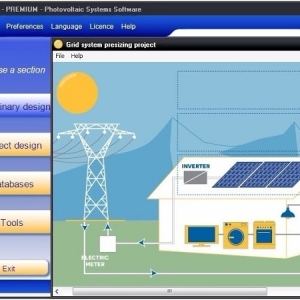



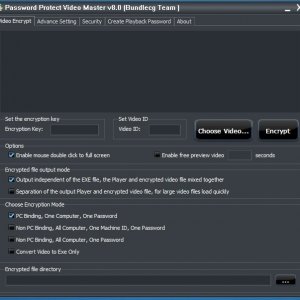
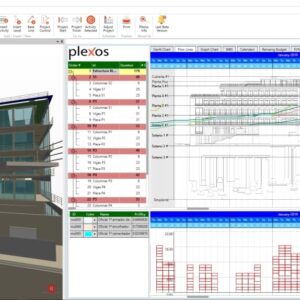




نقد و بررسیها
هنوز بررسیای ثبت نشده است.